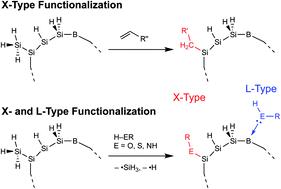当前位置:
X-MOL 学术
›
Faraday Discuss.
›
论文详情
Our official English website, www.x-mol.net, welcomes your feedback! (Note: you will need to create a separate account there.)
Modulating donor-acceptor transition energies in phosphorus-boron co-doped silicon nanocrystals via X- and L-type ligands.
Faraday Discussions ( IF 3.4 ) Pub Date : 2020-01-06 , DOI: 10.1039/c9fd00106a Gregory F Pach 1 , Gerard M Carroll , Hanyu Zhang , Nathan R Neale
Faraday Discussions ( IF 3.4 ) Pub Date : 2020-01-06 , DOI: 10.1039/c9fd00106a Gregory F Pach 1 , Gerard M Carroll , Hanyu Zhang , Nathan R Neale
Affiliation

|
In this work, we explore the effect of ligand binding groups on the visible and NIR photoluminescent properties within phosphorus–boron co-doped silicon nanocrystals (PB:Si NCs) by exploiting both the X-type (covalent) and L-type (Lewis donor molecule) bonding interactions. We find that the cooperative nature of both X- and L-type bonding from alkoxide/alcohol, alkylamide/alkylamine, and alkylthiolate/alkylthiol on PB:Si NCs results in photoluminescence (PL) energy blue shifts from the as-synthesized, hydride-terminated NCs (PB:Si–H) in excess of 0.4 eV, depending on the surface termination. These PL blue shifts appear greatest in the most strongly confined samples with diameters <4 nm where the surface-to-volume ratio is high and, therefore, the ligand effects are most pronounced. A correlation between the donor group strength (either X-type or L-type) and the degree of D–A state modulation is found, and the proportion of the PL blue shift from the X- and L-type interactions is quantified. Raman spectroscopy is used to provide additional evidence of the strength of the L-type donor groups. Additionally, we probe how the nature of the ligand chemistry affects the radiative lifetime and PL efficiency and find that the ligands do not significantly change the D–A emission dynamics, and all samples retain the long 50–130 μs lifetimes characteristic of these transitions. Finally, we describe three mechanisms that operate to affect the D–A recombination energies: (1) X-type ligands that modulate the PB:Si–X NC wavefunction; (2) L-type ligands that perturb the donor and acceptor states via a molecular orbital theory picture; and (3) X- and L-type ligands that cause a dielectric increase around the PB:Si NC core, which provides Coulomb screening and modulates the donor and acceptor states even further.
中文翻译:

通过X型和L型配体调节磷硼共掺杂硅纳米晶体中的供体-受体跃迁能。
在这项工作中,我们通过利用X型(共价)和L型(刘易斯)研究了磷硼共掺杂硅纳米晶体(PB:Si NCs)中配体结合基团对可见光和NIR光致发光性质的影响。供体分子)键相互作用。我们发现PB:Si NCs上醇盐/醇,烷基酰胺/烷基胺和烷基硫醇盐/烷基硫醇的X型键和L型键的配合性质导致了合成时的氢化物-光致发光(PL)能量蓝移端接的NC(PB:Si–H)超过0.4 eV,具体取决于表面端接。这些PL蓝移在直径<4 nm的最受限制的样品中表现得最大,在这些样品中表面体积比很高,因此配体效应最为明显。发现了供体基团强度(X型或L型)与D–A状态调制程度之间的相关性,并量化了X和L型相互作用中PL蓝移的比例。拉曼光谱法用于提供L型供体基团强度的其他证据。此外,我们探究了配体化学性质如何影响辐射寿命和PL效率,发现配体不会显着改变D–A发射动力学,并且所有样品均保留了这些跃迁的50–130μs较长的寿命特征。最后,我们描述了影响D–A重组能量的三种机制:(1)调节PB:Si–X NC波函数的X型配体;(2)干扰供体和受体状态的L型配体 定量分析了X和L型相互作用产生的PL蓝移的比例。拉曼光谱法用于提供L型供体基团强度的其他证据。此外,我们探究了配体化学性质如何影响辐射寿命和PL效率,发现配体不会显着改变D–A发射动力学,并且所有样品均保留了这些跃迁的50–130μs较长的寿命特征。最后,我们描述了影响D–A重组能量的三种机制:(1)调节PB:Si–X NC波函数的X型配体;(2)干扰供体和受体状态的L型配体 定量分析了X和L型相互作用产生的PL蓝移的比例。拉曼光谱法用于提供L型供体基团强度的其他证据。此外,我们探究了配体化学性质如何影响辐射寿命和PL效率,发现配体不会显着改变D–A发射动力学,并且所有样品均保留了这些跃迁的50–130μs较长的寿命特征。最后,我们描述了影响D–A重组能的三种机制:(1)调节PB:Si–X NC波函数的X型配体;(2)干扰供体和受体状态的L型配体 此外,我们探究了配体化学性质如何影响辐射寿命和PL效率,发现配体不会显着改变D–A发射动力学,并且所有样品均保留了这些跃迁的50–130μs较长的寿命特征。最后,我们描述了影响D–A重组能量的三种机制:(1)调节PB:Si–X NC波函数的X型配体;(2)干扰供体和受体状态的L型配体 此外,我们探究了配体化学性质如何影响辐射寿命和PL效率,发现配体不会显着改变D–A发射动力学,并且所有样品均保留了这些跃迁的50–130μs较长的寿命特征。最后,我们描述了影响D–A重组能量的三种机制:(1)调节PB:Si–X NC波函数的X型配体;(2)干扰供体和受体状态的L型配体 我们描述了影响D–A重组能量的三种机制:(1)调节PB:Si–X NC波函数的X型配体;(2)干扰供体和受体状态的L型配体 我们描述了影响D–A重组能的三种机制:(1)调节PB:Si–X NC波函数的X型配体;(2)干扰供体和受体状态的L型配体通过分子轨道理论图;(3)X型和L型配体会导致PB:Si NC核周围的介电增加,从而提供库仑筛选并进一步调节供体和受体的状态。
更新日期:2020-01-06
中文翻译:

通过X型和L型配体调节磷硼共掺杂硅纳米晶体中的供体-受体跃迁能。
在这项工作中,我们通过利用X型(共价)和L型(刘易斯)研究了磷硼共掺杂硅纳米晶体(PB:Si NCs)中配体结合基团对可见光和NIR光致发光性质的影响。供体分子)键相互作用。我们发现PB:Si NCs上醇盐/醇,烷基酰胺/烷基胺和烷基硫醇盐/烷基硫醇的X型键和L型键的配合性质导致了合成时的氢化物-光致发光(PL)能量蓝移端接的NC(PB:Si–H)超过0.4 eV,具体取决于表面端接。这些PL蓝移在直径<4 nm的最受限制的样品中表现得最大,在这些样品中表面体积比很高,因此配体效应最为明显。发现了供体基团强度(X型或L型)与D–A状态调制程度之间的相关性,并量化了X和L型相互作用中PL蓝移的比例。拉曼光谱法用于提供L型供体基团强度的其他证据。此外,我们探究了配体化学性质如何影响辐射寿命和PL效率,发现配体不会显着改变D–A发射动力学,并且所有样品均保留了这些跃迁的50–130μs较长的寿命特征。最后,我们描述了影响D–A重组能量的三种机制:(1)调节PB:Si–X NC波函数的X型配体;(2)干扰供体和受体状态的L型配体 定量分析了X和L型相互作用产生的PL蓝移的比例。拉曼光谱法用于提供L型供体基团强度的其他证据。此外,我们探究了配体化学性质如何影响辐射寿命和PL效率,发现配体不会显着改变D–A发射动力学,并且所有样品均保留了这些跃迁的50–130μs较长的寿命特征。最后,我们描述了影响D–A重组能量的三种机制:(1)调节PB:Si–X NC波函数的X型配体;(2)干扰供体和受体状态的L型配体 定量分析了X和L型相互作用产生的PL蓝移的比例。拉曼光谱法用于提供L型供体基团强度的其他证据。此外,我们探究了配体化学性质如何影响辐射寿命和PL效率,发现配体不会显着改变D–A发射动力学,并且所有样品均保留了这些跃迁的50–130μs较长的寿命特征。最后,我们描述了影响D–A重组能的三种机制:(1)调节PB:Si–X NC波函数的X型配体;(2)干扰供体和受体状态的L型配体 此外,我们探究了配体化学性质如何影响辐射寿命和PL效率,发现配体不会显着改变D–A发射动力学,并且所有样品均保留了这些跃迁的50–130μs较长的寿命特征。最后,我们描述了影响D–A重组能量的三种机制:(1)调节PB:Si–X NC波函数的X型配体;(2)干扰供体和受体状态的L型配体 此外,我们探究了配体化学性质如何影响辐射寿命和PL效率,发现配体不会显着改变D–A发射动力学,并且所有样品均保留了这些跃迁的50–130μs较长的寿命特征。最后,我们描述了影响D–A重组能量的三种机制:(1)调节PB:Si–X NC波函数的X型配体;(2)干扰供体和受体状态的L型配体 我们描述了影响D–A重组能量的三种机制:(1)调节PB:Si–X NC波函数的X型配体;(2)干扰供体和受体状态的L型配体 我们描述了影响D–A重组能的三种机制:(1)调节PB:Si–X NC波函数的X型配体;(2)干扰供体和受体状态的L型配体通过分子轨道理论图;(3)X型和L型配体会导致PB:Si NC核周围的介电增加,从而提供库仑筛选并进一步调节供体和受体的状态。



























 京公网安备 11010802027423号
京公网安备 11010802027423号